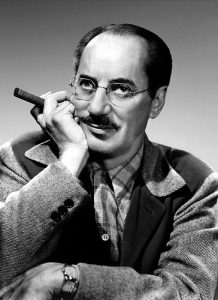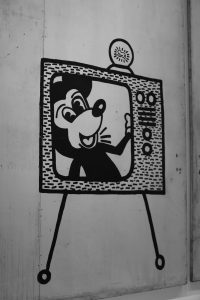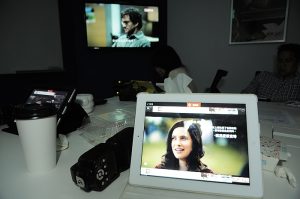Television through Time

“I find television very educating. Every time somebody turns on the set, I go into the other room and read a book.” — Groucho Marx
Television Revolution
When you talk to a parent, grandparent or great-grandparent about life at home before television, they will probably tell you that they listened to the radio and read books, magazines and newspapers. They may also mention spending time together telling old stories and listening to music on a record player.
It is no wonder that when television was first becoming America’s medium of choice in the 1940s and ’50s, many thoughtful people questioned the influence it could have on society. Television’s least-common-denominator sensibility concerned many, and some thought the entire entertainment industry was trying to turn the country Communist. Concerns about propaganda abounded. Of concern during the Cold War was that television would take that same power into people’s homes on a platform that was constantly updated and sometimes broadcast live. Just as with film, the battle for control over the influence of television has existed as long as it has been a mass medium. It is difficult to underestimate television’s cultural impact.
Besides those who saw television as a threat meant to spread Communism throughout the West, there were others who were not so radically against television but who preferred to talk about the importance of reading instead. They viewed television not as a tool of the intellectual, global left but as anti-intellectual. You will still encounter people who voice with pride — and often an air of superiority — that they do not own a television. They imply that everyone else may be rotting their brains, but not their family. Condescension about the television and its content dates back to the dawn of the medium. Groucho Marx, depicted above, was an early film and TV star, and even he joked about the lack of quality programming. Of course, television isn’t all bad. At every stage of the medium’s development, there have been thoughtful, intelligent shows and there have been shows considered dreck — that is, waste or trash that serves to fill time but not to inform meaningfully.
This chapter discusses the nature of television content as the medium evolved throughout the second half of the 20th century. It then briefly discusses the role of the television industry in society by examining the ways we watch TV and its possible impacts on our health. Finally, this chapter covers the medium’s influence on popular culture and explores how the 2000s and 2010s may have brought about the golden age of television while simultaneously opening up pathways for audience collaboration and shared cultural influence in what is perhaps the most culturally influential medium in human history.
Television Content in the 20th Century
This is not a dichotomy between the good old days of quality mass-market television and the modern garbage made to fill airtime on hundreds of digital channels. Rather, there has always been a dichotomy between informative programming and shows made purely for entertainment and distraction. As with all dichotomies, the boundary between the two is blurred.
Not every show on the low end of the intellectual spectrum is dreck. Even intellectually stimulating programs have moments of pandering. Television content generally strives to be popular and profitable first, entertaining second, and informational third, if at all. Consider some of the top-rated shows of each decade in the 20th century after television became popular. There were informative, educational programs, and there was silly and mundane fare in each decade. The 1940s saw the debut of Meet the Press, a news discussion show that is still on the air, as well as Howdy Doody, a children’s puppet show that set the tone for future children’s programming but lacked some of the educational elements that came with Sesame Street and similar shows. In the 1950s, the masterful journalist Edward R. Murrow led a journalistic team of titans with See it Now, a classic news documentary show. But he also hosted Person to Person, a celebrity profile show that bordered on tabloid TV. In the 1960s, Murrow made Harvest of Shame, a revolutionary television documentary about the oppression of farm workers. In the same decade, Mister Ed featured a talking horse that cracked jokes through a barn door. Producers persuaded the horse, a gelding named Bamboo Harvester, to “talk” by putting peanut butter on his teeth. The issue is not the existence of silly shows but their relative popularity. For every major in-depth documentary about poverty in America or some other heady topic, there were at least a dozen sitcom series that portrayed a peaceful, suburban, consumption-driven life even as American society underwent cultural and social upheaval.

In the 1970s, the sitcom M*A*S*H gained great critical acclaim. It showed that a television show could entertain and inform. It satirized the Vietnam War through comedy, although it technically was a depiction of the Korean conflict. The show discussed war propaganda, PTSD, the honor of service and camaraderie in battle. It ran for 11 years, longer than the Korean and Vietnam Wars put together. M*A*S*H can be compared to another classic ’70s sitcom, Three’s Company, a farcical show about three single people living together as roommates in post-60s sexual revolution Santa Monica, California. Both shows depicted social and cultural change, and both aired successfully for decades in reruns, but M*A*S*H represents television in rare form, both entertaining and poignant.
In the 1980s, Hill Street Blues was a serious, police drama that demonstrated the difficulty of fighting crime in an unnamed modern American city by tackling deep subjects and showcasing a gritty production style. In contrast, Married…with Children was a purposefully shallow show designed to offend by depicting a grotesque caricature of an American family. Hill Street Blues ran for seven seasons. Married…with Children ran for 11. In the 1990s, Homicide: Life on the Street depicted grit, violence and crime fighting in Baltimore in the vein of Hill Street Blues. Homicide was based on a non-fiction book titled Homicide: A Year on the Killing Streets by David Simon. Simon went on to create The Wire, one of the top-rated television shows of all time that also depicted crime and crime fighting in Baltimore. While Homicide was popular, Friends dominated American pop culture and had a global influence. Friends showed an imaginary version of New York where six twenty-somethings, some of whom had no discernible employment, could afford spacious apartments and daily lattes. This is not to take issue with shows that paint a rosy picture of life. Instead, the point is that popular television content is made to entertain, not inform. The most entertaining and popular shows of the 20th century were not poorly made, nor were they necessarily detrimental to society as mainstays of the culture. They were, however, usually void of thoughtful social content. Television, the most popular mass medium in the world, often serves to distract.
Television and Society
The shallow nature of some of the most popular television content in the 20th century raises a broader question about mass-media content in capitalist society. Can we expect a media system based on profit-making to focus on serious issues? Perhaps we should not expect the majority of television content to be informative or to treat social issues with nuance. After all, it may not be much different from the appeal of movies in the 20th century where hard-working people attended movies in part because they craved instant gratification and movies were affordable. In the early days of television, the television set was expensive, but the content was free and delivered over the airwaves from broadcast towers to antennas. To make money in this media environment, producers considered popularity first. Advertisers supported the medium and cared above all else how many “eyeballs” they could reach.
Scholars will often suggest that a “balanced” television diet is best. In other words, we should not expect for-profit television producers to forego revenues to deliver mostly informational content. Rather it is on us as consumers to seek out quality programming and limit our “guilty pleasures” when viewing TV. Ratings suggest most people are just fine watching shallow television, and many will binge-watch TV for days. As consumers, we will probably have more success holding ourselves to better consumption standards than we will have trying to hold producers to more positive social standards. In a crowded marketplace of broadcast, cable, satellite and streaming television, quality content stands out.
Industry Shifts
Cable television started as a way to reach rural consumers and grew, particularly in the 1980s and 1990s, into a nationwide service delivering paid content. It presented more options and a trustworthy wired connection — but at a cost. As cable networks consolidated into monopolies, costs went up and service quality often declined. Still, most Americans continue to consume broadcast and cable television. Market penetration of some form of television service, including over-the-air TV, stands at almost 96% according to Nielsen, the television ratings specialists.
According to industry estimates, pay television services (such as cable and satellite TV) are now in fewer than 80 percent of U.S. homes as people begin to “cut the cord.” Broadband internet service now reaches more than 80 percent of homes, suggesting that it is displacing paid television services. American cable consumers may be comfortable transitioning to broadband because so much television content is now available online. Netflix, Hulu, Amazon Prime Video, HBO GO and other broadband-based streaming services deliver television content with high production value. YouTube, Vimeo, Twitch and other streaming services deliver niche video content. Certain platforms for television delivery may be in decline, but consumption of video content remains strong.
Television’s impact on society is debated by scholars. Long-term studies have associated higher rates of television viewing with lower rates of high school completion. Watching television has been shown to make attention spans shorter. Media studies scholars do not agree on whether television “cultivates” a sense that the world is a violent, scary place, even when crime rates are low. Findings for that hypothesis seem to depend on how each study is carried out and how data analyses are structured. Alternatively, educational television can have a positive impact as an intervention for children in poverty. Too much television has the potential to affect us negatively. Doctors often recommend limiting screen time, particularly for children. The way we consume television has changed a great deal since the medium was introduced.
Appointment Viewing versus Binge-watching
Appointment viewing refers to the phenomenon of people watching television shows at the same time each week or each day. When most people watched television broadcast over the air or on cable, they generally had two options. They could watch the show live as it aired, or, once the VCR was invented, they could record programs to watch later. A major concern during the mid-20th century when appointment viewing was most popular was that people might not watch serial narratives on television because they would have to wait a week between episodes. If they missed an episode or two, they could feel lost and stop watching the show.

Thus, appointment viewing and episodic TV went hand in hand for a majority of shows during the 20th century. Episodic television shows usually featured a different story with each episode. Soap operas, however, were serialized. They told an ongoing story with several threads, and each episode picked up where the last one left off, but they aired almost every weekday, and the stories were not known for being complicated.
The logic against making serial television dominated the 1980s and 1990s, but in the 2000s dramatic shows such as The Sopranos, The Wire, Breaking Bad, MadMen, Deadwood, Dexter, Boardwalk Empire, Six Feet Under, Lost, 24, Homeland, Game of Thrones, Westworld, Stranger Things, and The Handmaid’s Tale became increasingly popular. DVRs (digital video recorders) and streaming services contributed to the popularity of these dramas and to the habit of binge-watching — consuming several hours of video content in a single viewing or in a very limited time frame.
The upside is that many shows now present intricate plots with long-building character arcs. Many former filmmakers, screenwriters and actors now prefer to do television rather than film because television allows for more intricate storytelling. Not everything in popular television needs to have the potential to reach a global audience interested in action, superheroes and sexy, simplistic love stories. While it is true that many independent films pursue visual storytelling as an art form, such releases are limited. In many ways, television (including shows broadcast on streaming services) now leads the way in attempting to make cultural and social impacts. Of course, instant gratification television still exists. So-called “reality television” is still popular, as are game shows and myriad live sporting events, but it can still be argued that the highest form of the visual storytelling art may now be seen on the small screen.
Television and Health
Streaming television content may be as socially relevant as ever, but it encourages binge-watching, which can contribute to health problems. The content itself might not harm your health, but binge-watching and general overconsumption lead to unhealthy sedentary lifestyles. Researchers have found links between increased television viewing and obesity, smoking rates, and generally low fitness levels. Netflix, Amazon and Hulu are engaged in a fierce competition to create the most binge-worthy content, and this means that binge-watching is not going away any time soon. Again, mitigation of the social impact of television will fall on the consumer’s shoulders.
Socially, television is an incredibly powerful medium. Most media studies scholars agree that it has the potential to enable shared social understanding. Televised images of atrocities helped encourage the Civil Rights Movement and the end of the Vietnam War. Educational and informational programming is required of broadcasters, and many consumers find valuable shows amidst the information glut; however, the future of television might be darker than the present age of quality and variety.
As television content moves online and streaming services become more popular, there is a massive corporate push to give internet service providers (ISPs) the kind of control over content that cable television providers have had in the past. The end of net neutrality could make streaming services more expensive, and though it is not likely to happen rapidly, internet access could be divided into tiers of websites and web services with ISPs charging more for the most popular sites. If the most binge-worthy, least intellectually valuable content becomes the affordable option for most people, the social impact of the new internet-television regime could be negative for generations to come.
Television and Culture
The cultural impact of television could be implied from the discussion of content through the decades. Regular television viewers make connections with storylines and characters. We can consume an eclectic mix of video content or focus only on the genre that interests us most. There are hundreds of digital channels and seemingly endless amounts of streaming content available at all time. The question is not whether there is something interesting to watch but what type of content interests us the most. There is more to the medium than the dramas and distractions of the 20th century. There is no single television culture emerging in the 21st century since mass audiences have an incredible variety of choices; however, for children of the 20th century, there are many shows that millions of people hold in common. Thus, we are transitioning from a time of a shared “TV culture” to a time of various digital content cultures.

For children of the 20th century, television is so ingrained in our culture there are shared references to shows that have not aired for 20 years, and there have even been shows about watching TV. Specifically, the HBO show Dream On depicted a grown man who recalled old television shows when his short attention span sent him off into daydreams. Popular television shows in 20th-century American culture were so familiar to mass audiences that there are still common tropes from as many as 50 years ago that most viewers would recognize. The image of the dull husband and his feisty wife echoes through the decades from The Honeymooners through The Simpsons, King of Queens and Family Guy. The crime procedural has been so popular for so long, it often seems as though an entire generation of TV stars have made at least one appearance on Law & Order. Other tropes are noted in “The Simpsons 138th Episode Spectacular,” another example of television culture referencing itself.
We now use all manner of devices to connect to television content. Over-the-air television is gaining in popular support as people cut the cable cord. Streaming services, as stated, are beginning to dominate the landscape. Smartphones and tablets offer ways of consuming streaming television as well as amateur video programs as well as the opportunity for a second screen experience, which refers to watching something on television and interacting with the show or with fans of the show on social media and other Web platforms. The convergence of media platforms opens up new ways of engaging with video content and the people who produce it.
The cultural implications of participatory or collaborative television — the phenomenon in which content producers work with the audience to produce, alter or enhance content, including to decide the outcomes of televised competitions — are not yet known. It is expected, however, that the practice will continue to grow. Audiences often enjoy having a say in the direction or the outcome of a program. Digital platforms measure audience engagement as something they can market to advertisers, which encourages the practice. This also puts some responsibility on the part of consumers to positively influence the content they help shape.
As television and broadband internet services merge, it is worth noting that the prediction of the union of television and computers is as old as the personal computer. Internet-ready televisions might have become more popular than add-on streaming devices such as Amazon Fire, Apple TV, Roku, or Google Chromecast, but television manufacturers hesitated to add full internet functionality for fear of viruses. Also, consumer demand for connected TVs was not strong enough for manufacturers to offer built-in technology. For the consumer, it matters little whether the television connects directly to the internet or whether a relatively inexpensive add-on is needed. In whatever manner you connect to converged digital video content — that is, the media products formerly known as television — you have access to perhaps the most influential cultural tool in history.

